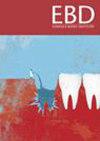In mild to moderate crowded cases, is there a difference in orthodontic treatment duration between clear aligners and fixed appliances?
Q3 Dentistry
引用次数: 0
Abstract
The Cochrane Central Register of Controlled Trials (CENTRAL), PubMed, Scopus, Web of Science, Google Scholar, Trip, CINAHL via EBSCO, EMBASE via OVID and ProQuest searched up to June 2023. Any clinical study with parallel arms and matched malocclusion severity should include permanent dentition participants with mild to mild-to-moderate anterior crowding. Participants should have undergone orthodontic treatment with either orthodontic labial fixed appliances or removable clear aligners. Total treatment time (primary outcome), chair time, number of appointments, and emergency visits (secondary outcomes) should also be reported. Two reviewers selected the studies to be considered in two stages. If needed, a third reviewer was included to solve discrepancies. Endnote and Rayyan software supported the process. The same two reviewers independently extracted the required data from the included studies. If needed, a third reviewer was included to solve discrepancies. Endnote and Rayyan software supported the process. Ten studies were finally included (six RCTs and four non-RCTs). Only one included samples in which teeth were extracted due to crowding. The total included sample was 718 participants (aged 20–29 years). Only one study did not report crowding equivalency between groups. Based on low to very low certainty levels, treatment duration is likely similar, chair time and emergency visits are less frequent, and the number of appointments is increased with clear aligners.对于轻度至中度拥挤的病例,透明矫治器和固定矫治器的矫治时间是否有区别?
数据来源截至 2023 年 6 月,已在 Cochrane 对照试验中央注册中心 (CENTRAL)、PubMed、Scopus、Web of Science、Google Scholar、Trip、EBSCO 的 CINAHL、OVID 的 EMBASE 和 ProQuest 进行了搜索。任何具有平行臂和匹配错合畸形严重程度的临床研究都应包括轻度至轻度至中度前牙拥挤的恒牙期参与者。参与者应接受过正畸唇侧固定矫治器或可摘透明矫治器的正畸治疗。还应报告总治疗时间(主要结果)、治疗椅时间、预约次数和急诊次数(次要结果):两名审稿人分两个阶段选择要考虑的研究。如有需要,第三位审稿人也会参与其中,以解决差异问题。数据提取与综合:同两名审稿人从纳入的研究中独立提取所需的数据。如有需要,第三位审稿人也会参与其中,以解决差异问题。Endnote 和 Rayyan 软件为这一过程提供支持:最终纳入了 10 项研究(6 项 RCT 和 4 项非 RCT)。只有一项研究纳入了因牙齿拥挤而拔牙的样本。纳入的样本总数为 718 人(20-29 岁)。只有一项研究未报告各组之间的牙齿拥挤程度:根据较低至极低的确定性水平,透明矫治器的治疗时间可能相似,治疗椅时间和急诊就诊次数较少,预约次数增加。
本文章由计算机程序翻译,如有差异,请以英文原文为准。
求助全文
约1分钟内获得全文
求助全文
来源期刊

Evidence-based dentistry
Dentistry-Dentistry (all)
CiteScore
2.50
自引率
0.00%
发文量
77
期刊介绍:
Evidence-Based Dentistry delivers the best available evidence on the latest developments in oral health. We evaluate the evidence and provide guidance concerning the value of the author''s conclusions. We keep dentistry up to date with new approaches, exploring a wide range of the latest developments through an accessible expert commentary. Original papers and relevant publications are condensed into digestible summaries, drawing attention to the current methods and findings. We are a central resource for the most cutting edge and relevant issues concerning the evidence-based approach in dentistry today. Evidence-Based Dentistry is published by Springer Nature on behalf of the British Dental Association.
 求助内容:
求助内容: 应助结果提醒方式:
应助结果提醒方式:


